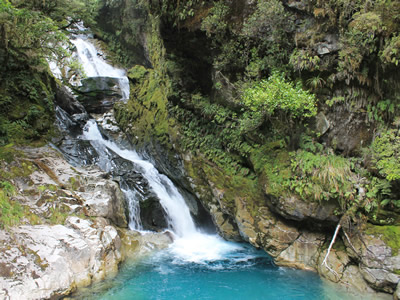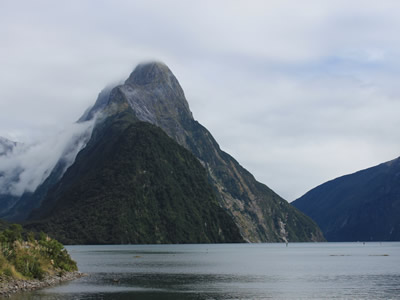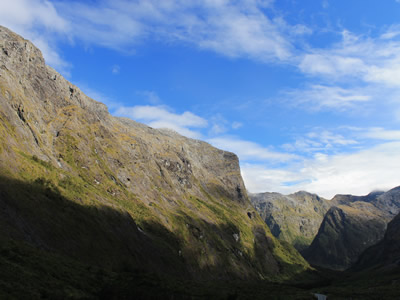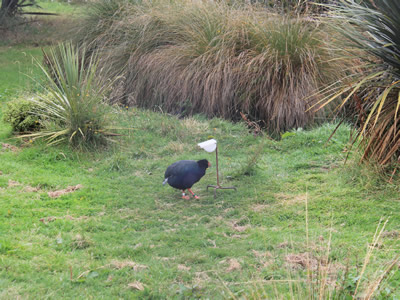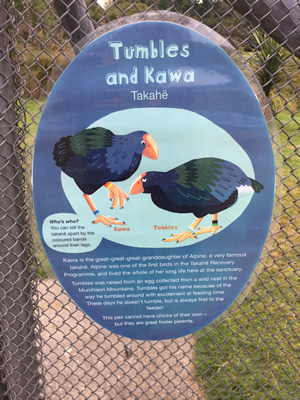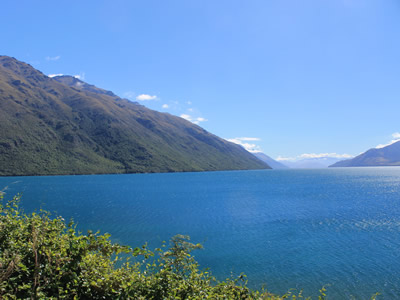NZ pt2 - Te Anau
After an overnight flight with little sleep we crashed early when we got to Queenstown. We stayed at a Doubletree Hotel near the airport where it only cost us some of Sandy's Hilton Points. She accumulated a lot of them while she was a VP at Hewlett Packard.
Since New Zealand is nineteen hours ahead we were up at 5am. That was equivalent to sleeping in till ten at home so we were well rested and ready to go. We even got breakfast included which made Sandy happy since she's a breakfast person.
Tipping isn't common in New Zealand so breakfast really was free. It does mean that there is a difference in service compared to the US though. This was demonstrated when Sandy asked a server who walked by if she could get some more coffee. He looked at her and asked "You mean now?"
After breakfast it was a two hour drive to Te Anau, where we would be staying for two nights. The drive wasn't particularly exciting. It was overcast and raining so we couldn't see the mountains. The whole day was pretty much like that, but fortunately there was stuff to do inside. We stopped at the Fiordland National Park visitor center. We spent a lot of time in the local shops. Sandy found a yarn shop that carried some unique yarns made in New Zealand. The country has less than five million people and thirty million sheep, so wool goods, yarn and anything to do with sheep are a big deal. Sandy found some cool stuff for herself and also picked up some gifts for friends.
There was a jewelry store that carried a lot of nice pieces made from Paua shell. Paua is the Maori name for abalone and jewelry made of the polished shells was highly valued by the Maori. It is still iconic in New Zealand. It's beautiful and relatively inexpensive so we bought several nice pieces as gifts. We like to do Christmas gifts from our travels.
And of course, I managed to find a couple of tshirts.
We were staying at the Fiordland Lakeview Apartments. We had a one bedroom apartment rather than a hotel room. That was nice because on a rainy day we spent more time in our room than we otherwise would have and had a lot more space. Lake Te Anau was right across the street and the view would have been gorgeous on a bright sunny day. Unfortunately we didn't get one while we were in Te Anau. That's the way it goes. The weather in New Zealand, especially in Fiordland, is always a crapshoot. You will get some rainy days and hopefully, if you are lucky, some nice sunny days.
The next day it was overcast but at least it had stopped raining. We decided to take a drive to Milford Sound. The only road access is from Te Anau. Although the road is just 120 km (about 75 miles) it takes a good two hours each way. We also planned to stop at a number of viewpoints and maybe do some short hikes as long as it wasn't raining. We figured that it would take a full day. We had been to Milford Sound on our last trip to New Zealand but had not driven the road. We hiked the Milford Track to get there, and took a helicopter back to Queenstown when we left.
After crossing the Southern Alps the clouds actually broke up and we had the first blue sky of the trip. We stopped to get some photos. The Fiordland mountains looked spectacular. It didn't last long and by the time we got to Milford Sound it was solid overcast again. It is still one of the most amazing places in the world. Everyone needs to come here at least once in their lifetimes. We took a short walk along the shore and took photos of Mitre Peak towering over 5000 feet above the sound. We had been lucky enough to have a beautiful sunny day in Milford Sound back in 2008 after we hiked the Milford Track.
On the way back we made several stops. At The Chasm a fifteen minute hike led to a view of the Cleddau River plunging over waterfalls at the bottom of a seventy foot deep chasm. An added attraction in the parking lot were several keas, the only alpine parrot in the world. They are beautiful birds but can be a nuisance. They can use their powerful beak to tear a hiker's pack to get at food inside. They are like the New Zealand equivalent of ground squirrels for hikers.
At another point on the road there was a waterfall spilling into a beautiful blue-green pool. There was no parking area. I just pulled off onto the shoulder of the road so I could get a picture. It was quite impressive and since then I have seen the identical image on several websites. I felt lucky that we had spotted it.
Finally we took a two mile loop hike to Lake Mistletoe. It was underwhelming. We were out of the mountains. The trail went to the lake, which was not that impressive, and then looked to go around it. But instead it veered off and returned to the road where a sign said "follow road back to trailhead". So we ended up hiking the last half mile along the narrow road, watching every time a car came along to make sure we were safe. Not recommended.
The next morning was still overcast. It was time to leave Te Anau and head back to Queenstown. But before we left we did a short hike. We parked at the visitor center and hiked along the lake to the start of the Kepler Track. The walk was pleasant but it was too bad it was cloudy. It would have been very pretty on a nice day. We passed a bird sanctuary where we saw two takahe. They are a bird species that was thought to be extinct but was rediscovered in 1948 in the Murchison Mountains, the mountains just across Lake Te Anau from where we were. They are critically endangered but New Zealanders are working very hard to preserve them.
The problem for the takahe is the same as for many of New Zealand's native fauna. Since New Zealand has no native land mammals, most of the ecological niches filled by mammals in the rest of the world are filled by birds in New Zealand. With no mammal predators as competition, many of the birds lost the ability to fly. When Europeans came to New Zealand they brought mammals with them. Many of these introduced species, such as dogs, cats, rats and stoats, have devastated the native populations of birds which have no defense against them. The stoat in particular has almost wiped out the takahe population. The Department of Conservation has tried to exterminate the introduced "pests" but has not been successful. So they carry on an effort to control the mammal population to protect the native birds but it is a constant battle.
We walked as far as the trailhead for the Kepler Track. It is the newest of the Great Walks of New Zealand. It was opened in 1988 to relieve pressure on the Milford Track and Routeburn Track, which are so popular that hikers need to be limited. It didn't help, as they both still have to be limited in the number of hikers as more people want to walk them then the tracks can sustain. But it was successful as the Kepler is busy as well, booked to capacity. Whether opening the Kepler increased the number of hikers or just absorbed the growth that occurred anyway isn't clear.
After our hike it was time to drive back to Queenstown. It had been cloudy during the time we had been in Te Anau. That was disappointing but the weather in New Zealand is variable. There will always be rainy days on any trip. Next up for us was the Routeburn Track and the forecast was for the weather to improve. Although it would have been nice to have good weather in Te Anau, at least there we had a lot of space where we stayed and were comfortable. We got in some good shopping and did some car touring and easy hikes. Now on the way back to Queenstown the weather was improving and by the time we reached Lake Wakatipu we had blue skies and sun. We were optimistic for the next part of the trip.
